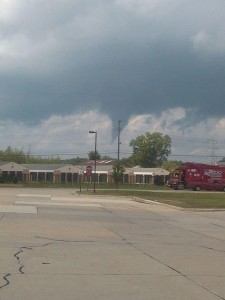 On Wednesday afternoon, August 20, 2014, a small tornado spun up beneath a seemingly garden-variety summer thunderstorm and did EF0 damage in Lennox Township on the eastern side of the state. I first became aware of it courtesy of a Facebook post by fellow Michigan-based storm chaser C. J. Postal. He wrote, “I give up. You win, Michigan.” Underneath was a photo of an unmistakable, nicely shaped funnel cruising over the treeline.
On Wednesday afternoon, August 20, 2014, a small tornado spun up beneath a seemingly garden-variety summer thunderstorm and did EF0 damage in Lennox Township on the eastern side of the state. I first became aware of it courtesy of a Facebook post by fellow Michigan-based storm chaser C. J. Postal. He wrote, “I give up. You win, Michigan.” Underneath was a photo of an unmistakable, nicely shaped funnel cruising over the treeline.
My first thought was, What does he mean? The photo couldn’t have been taken in Michigan. No way. It simply wasn’t tornado weather–no ripping jets, no curved hodographs, just weak westerly winds and, here on the west side of the state, beautiful, cloudless skies. Over on the east side, the radar showed just a scattering of small red zits around the thumb and down by Ann Arbor: bland, pulse-type storms capable of squeezing out a few bolts but certainly not a tornado.
Yet as you can see from the photo,* one of them did spin up a tube. The National Weather Service logged the following report.
A BRIEF EF0 TORNADO TOUCHED DOWN AROUND 204 PM ON PLACE ROAD BETWEEN 29 MILE AND 30 MILE ROAD IN LENOX TOWNSHIP. PATH LENGTH WAS ESTIMATED TO BE 0.25 MILES WITH A PATH
WIDTH OF 100 YARDS. WIND SPEEDS WERE ESTIMATED TO BE 75 MPH. FIRE OFFICIALS REPORTED SEVERAL TRAILERS BEING BLOWN OVER AS WELL AS A ROOF TO A GARAGE BEING TORN OFF.
What the heck happened?
Michigan happened.
Seriously. Not only does this state not get tornadoes when conditions look ripe for them, but it does get them when no one expects them. It happened a couple years ago in Dexter. It happened last month just a few miles from me in Cutlerville. And now, two days ago, it happened over near Macomb.
Wind profiles were unimpressive. Bulk shear was negligible. About the only things in place, as I recall, were adequate surface-based CAPE and moisture, but this was by no means supercell weather. “Severe” just wasn’t in the picture.
However, one easily overlooked element unique to the Great Lakes probably was present and might well have been the culprit. That ingredient? The onshore breeze blowing off of Lake St. Clair.
Twenty-six miles long and twenty-four miles wide, with 430 square miles of surface area, the lake is the largest body of water in the Great Lakes region after the Great Lakes themselves. It is easily large enough to generate its own lake breeze. On its western shore, that breeze is an easterly breeze which, backing against an overall westerly wind regime, can enhance low-level helicity or even produce it when none would otherwise exist.
That’s my theory, anyway, and I think it holds true not just for Lake St. Clare but even moreso for the western sides of Lakes Huron, Erie, and Michigan, where the lake breezes blow inland from the east. Storms moving into such an environment may, under the right conditions, get just the added low-level twist they need to turn an ordinary updraft into a tornado.
That, I believe, is what happened last Wednesday. The mechanism was probably that of a landspout. It certainly wasn’t that of a supercell thunderstorm. None of the storms I saw on the radar that day looked capable of producing a mesocyclone; they were non-severe little blips on the radar. But they were surface-based. And that combination of an updraft with preexisting vertical vorticity evidently did the trick.
I’ve seen enough other examples of storms in this state that went tornadic, or at least developed rotation, as they approached the eastern coastline to think that the lake breeze plays a role in a good percentage of cases. No doubt the same holds true for the northern Chicago area north up into Wisconsin inland from Lake Michigan.
What I’m saying may be nothing new to NWS meteorologists, but I don’t recall ever seeing it discussed. Then again, I rarely read KDTX’s forecast discussions, so maybe that’s why. I’m a KGRR man, but here in West Michigan, while our westerly lake breeze creates convergence, I doubt it contributes to helicity in the same way as the easterly breezes coming off of Lakes Huron, Erie, and St. Clare.
I’ve never seen the lake breeze’s possible role in storm rotation and tornadogenesis discussed to any great extent, and I think it merits recognition as a uniquely Great Lakes phenomenon. So I’m throwing it out here, with the caveat that I’m just an amateur forecaster, not a trained meteorologist. It would be great to get the thoughts of professional forecasters as well as other Great Lakes storm chasers who have considered how the easterly lake breeze may sometimes enhance storm severity.
———————-
* I would like to credit the photographer, but having exercised due diligence, I’m unable to locate that person. If you took the picture, or if you know who did and how I can reach them, please contact me.

